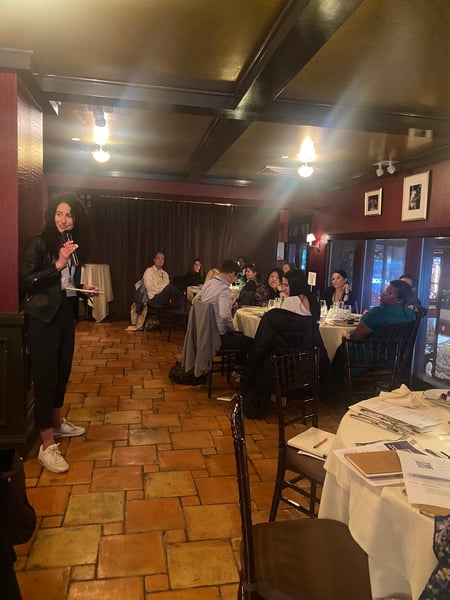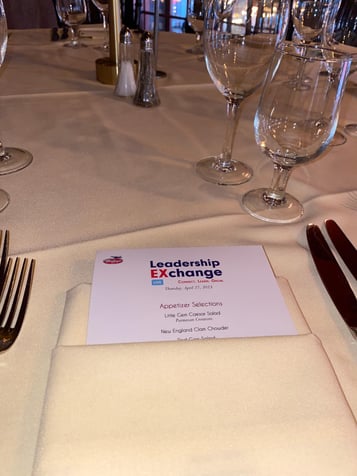New York City - Q2 2023
“The most exciting breakthroughs of the twenty-first century will not occur because of technology, but because of an expanding concept of what it means to be human. John Naisbitt”
The ongoing challenge in 2023 - How do we go about navigating global uncertainty and change and continue expecting more from our leaders? How do we navigate this? How do we justify investing in leadership development, and potentially justifying time spent in development experiences, when organizations feel the pressure to be focused on productivity and things that directly contribute to the business?
This can seem like an extremely difficult situation to navigate, but we MUST invest in our leaders! Why?
Well, we rely on leaders to help us navigate the unpredictable world and grow. Top leaders excel at ambiguity, instilling trust, and helping others reach their full potential.
These were the exact types of questions we explored with a group of 25+ executive-level HR, People & L&D leaders this last week.
As a follow-up, here are a few of the takeaways we walked away with (From the discussion as well as came from research by Harvard Business Review Analytic Services, sponsored by Torch).

Question #1: How are top-performing organizations meeting today's challenges, and how are their leadership development practices (LDP) evolving?
Evolving Practices From The Field:
- Leadership development practices are becoming more personalized – what used to be leadership skills training is turning into more peer group coaching, mentoring, and personalized experiences.
- The prioritized skills are being redefined – For the best in my opinion! organizations are really seeing the need to evolve leadership styles and skills from authoritative leadership styles to trust-based ones. Because of the global crises and workers who are more motivated by workplace values and commitments to cultural elements like diversity, equity, and inclusion, the skills to lead workers continue to be more redefined towards a more relational skillset. The need to motivate and communicate empathetically.
- Leadership development practices have become more inclusive – historically, LDP was primarily offered to the senior executives and the top 10% of the organization. Today, these practices are being deployed across the organization and see the need to be inclusive of their mentoring and coaching programs.
- The direction of investment – Everyone is prioritizing any investment within leadership development towards leadership skills training, mentoring, and leadership coaching.
Question 2 - What are some of the key impacts to look for and how do we unlock them?
It's typical for organizations to primarily track attendance and initial feedback on these development experiences. But to gain additional funding, and ensure your programs are making the intended impact, there are other metrics you need to track. A few of these include:
- The top benefit is better collaboration & teamwork.
- Increased employee engagement
- Better performance
- Increased emotional intelligence.
To unlock some of these returns… Here are a few best practices discussed in the program:
- Align leadership development with business objectives. Ensure that these developments are aligned with both the personal development path internally but also, more importantly, the future vision and business strategy.
- Customize to their organization's needs. Don’t rely on out-of-the-box programs, but tailor the investments to your unique culture.
- Invest in relationship-based initiatives. Seemed very clear that leveraging coaching & mentoring programs are some of the most effective strategies – both for the business and the morale of the culture. Especially in fostering a collaborative environment.
- Measure results. Yes obviously, but make sure you are using multiple metrics when evaluating the results. From reviewing 360 assessments to rates of promotions… Some of the best measure impact in many ways and go beyond employee participation or satisfaction and focus on other business outcome metrics as well.
- Ensure consistency. Consistency seems to be a gap at times. To foster a true growth mindset and culture internally, we have to develop ourselves and our people on an ongoing basis. A number of organizations found working with third-party groups to help design, manage, and measure programs to be helpful.
- Build with an inclusive lens. Increase your programmatic access to high-potential and underrepresented groups. Find ways to connect and design strategies that offer development to people across levels.

A Shared Challenge: A ongoing challenge that was shared consistently is that their leadership programs are under-resourced. L&D, HR, and people leader departments struggle to secure adequate funding for the initiatives they know are effective.
Question 3 - How can organizations create strategies and programs that better demonstrate the impact to drive continued investment?
Some tips & tactics for this challenge.
- Create consistency to help measure effectiveness. The lack of consistency makes it harder to measure ROI and ultimately secure more funding. Put controls in place to ensure your programs are consistently executed and measured.
- Expand and systematize ROI measurement. More successful funded programs tend to measure the success of their programs with a wider array of metrics. Most groups are rarely measuring organizational-level ROI metrics. Need to measure the overall outcomes of programs against KPIs like retention, promotions, and engagement, rather than simple participation. Most of the time, we can't gain an adequate budget due to the lack of ROI measurements.
- Build an aligned leadership development strategy with the organizational strategy. You have to be able to tell the story of how this development strategy will support the organization in achieving its own strategy.
Some Closing Thoughts:
Organizations, L&D, and people leaders are facing pressures that are redefining what skills are needed to thrive at work.
To thrive in this economy and world of work, leaders need to face these challenges head on, and use them as an opportunity to adapt, to differentiate in their market, and to attract & retain talent.
Those that do are reaping the business rewards. There are a few initial first steps you could look at.
One would be to become aware and honest of what isn't working. When coming to the table with new programs, it can feel like this ‘additional’ thing people have to do now. Before adding something new, take a look at some of the things you should stop doing.
The next would be to ensure programs are well aligned with the culture and the strategic direction. This will further ensure buy-in and engagement when it comes to launching the program itself. You also need to expand on how you are measuring results. Most of the time, we measure engagement in the program itself. Such as the percentage of people that actually showed up. Yes, that’s difficult enough and something worth tracking but it isn't what secures additional funding. You have to track deeper than that and look at things such as retention and performance. A leader shared that they constantly do stay interviews & 360 reviews with members to get an idea of how these pieces of training are making an impact and retaining talent.
Another would be to really look at your relationship-based initiatives like coaching and mentoring. These tend to be the most aligned with business objectives. When starting or evaluating your own practices, ensure to customize programming to the organization’s needs. These relationship-based programs can be in a model of peer groups, cohorts, buddy systems, or accountability partners. Either way, this is an impactful way to develop people while also building connections. If you need help with this, engage with us to learn more about the peer-to-peer learning communities we are building.
It seems like a lot but take note – you don’t have to do this alone. Either find external support, or do what I always love, which is bring your people into the room and co-create these experiences, strategies, and programs with them!





